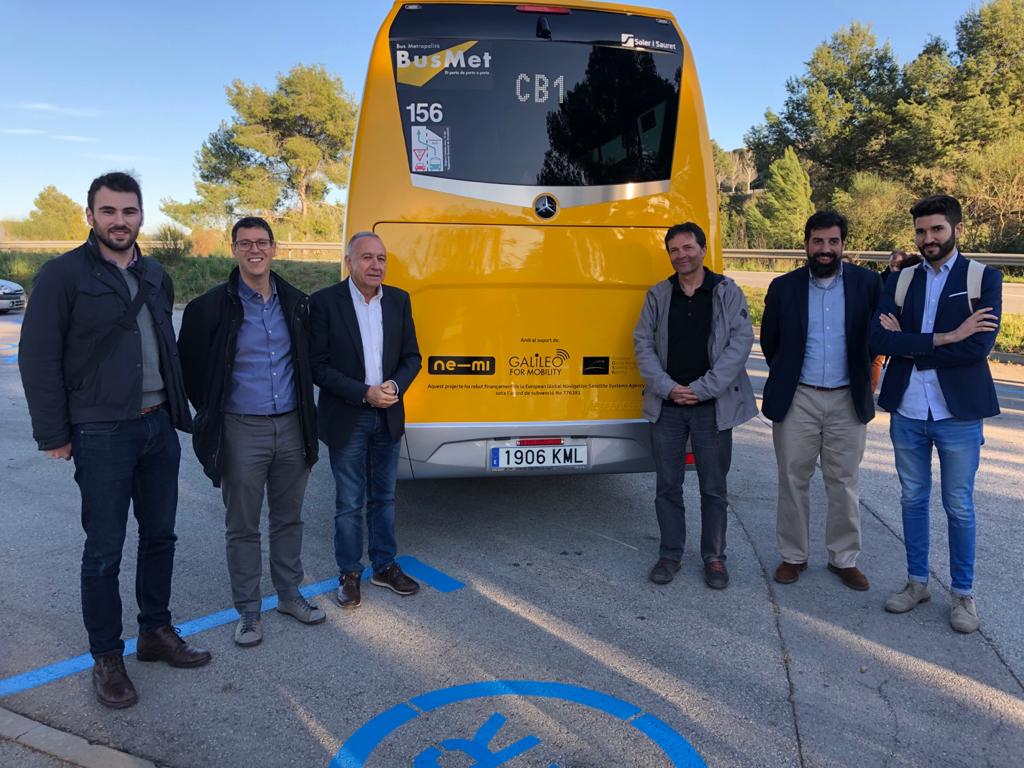After the pilots in Thessaloniki, Paris and Barcelona, another Galileo 4 Mobility pilot has kicked off! Taking place in Cervelló, a small town near Barcelona, this new pilot will test an on-demand bus service enabled with GALILEO technology. We spoke to PILDO Labs, who together with AMB (Metropolitan Area of Barcelona) leads the pilot.
Can you briefly discuss the pilot, and elaborate on how the service will benefit from Galileo technology?
The pilot in Cervelló aims at exploring the potential for on-demand bus schemes to replace regular bus services in areas with low population density. Cervelló is a small and geographically dispersed town in the Metropolitan Area of Barcelona where citizens living in the suburbs are connected to the densest part of town by one bus operating three fixed lines. This bus performs two expeditions a day for each bus line, between 10am and 2pm, which results in a very low service frequency.
With the goal of covering a greater territory and increasing ridership, two flexible bus lines are being tested in the afternoons to complement the existing fixed lines, which are still running in the mornings. The operation of these flexible lines is possible thanks to a platform which allows citizens to book seats by indicating origin, destination and time of their desired trip. The possibilities are based on the stops and schedule previously defined with the Metropolitan Area of Barcelona (AMB), the public authority responsible for mobility planning. Once there is at least one request for a specific area and time, the optimal route to serve such request is computed by the platform and communicated to the user. Fifteen minutes before the start of that expedition, the final route is processed and communicated to the driver through an on-board tablet, including on-route navigation.
Geo-positioning is critical for the service, since the driver must know at every moment where the vehicle is exactly and where it must head. It is also important for users to be able to know where the vehicle is (via the user’s mobile phone app) while they are waiting for it and to follow the vehicle’s position once they are on it. GALILEO technology is providing users with a more precise positioning of the vehicle and helping drivers to correctly execute the planned itinerary.
What is the current status of the pilot, and what are the next steps?
The pilot was launched on 26 February and, in its first phase, running in the afternoon, complementing the regular bus service of the morning. If the pilot proves to be a suitable solution for the mobility needs of Cervelló’s inhabitants, AMB is planning to expand the service to the morning as well and, thus, completely replace the regular bus service.
In the coming months, we will focus on adjusting the definition of the service to optimise operations by assessing its performance during the pilot test. We will also work on implementing some features to improve user experience, such as a better management of the pick-up time variability at certain stops.
Can you explain how the new service will benefit the user?
In low population density areas, regular bus services are inefficient, because they travel many kilometres without picking up or dropping off any passenger, wasting users’ time and public transport providers’ resources. They can also be ineffective as they consist of long routes with low frequency and limited coverage due to time constraints. As a consequence, people in low density areas either have no access to public transport or many are offered a public bus service which cannot satisfy their needs, leaving them with no affordable alternative to private means of transport.
Demand-responsive public transport not only increases efficiency of existing services by optimising all the resources involved in their operation —vehicles, energy, money and time—, resulting in shorter travel times and higher frequency, but it also allows to reach further, thus improving access to public transport.
Were there any challenges faced when setting up the pilot in terms of regulations, technology, or other?
The main challenge the pilot faced for its deployment was its condition of being a public service. AMB is a public authority, and as such, it could only launch the service through a public tender aimed at transport operators. On top of that, it was the first time AMB was designing a tender for an on-demand bus service, so it took longer than usual to create and internally approve its technical documents. This delayed the whole process associated with the public tender by several months.
What is the view of the city authority of the pilot?
As explained earlier, providing regular bus services in low-density areas is very costly and does not properly tackle challenges such as making public transport accessible for as many people as possible and providing a good alternative to private means of transport, making it a flawed model from both the public administration’s and the user’s point of view. AMB is eager to assess the performance of on-demand bus services in this kind of areas because that is where it has identified a great potential for improving existing regular bus services and deploying new bus services where it was not economically viable before.
Additionally, the platform has been built from the beginning based on the requirements and needs of AMB, since we both work in close partnership through the Galileo for Mobility project, and is continuously being shaped by the vision of public administrations through this and other pilot tests that we are currently executing. It is in our values to provide the best service not only for our users but for society as a whole. Indeed, public transport services operated with our solution can save kilometres travelled by avoiding covering areas where no one is hopping on or off the vehicle, thus reducing congestion, energy consumption and emissions of CO2 and air pollutants.
When will the results of the pilot be available, and what will be done with the insights?
The results of the pilot will be available at the end of the project (April/May 2020), since the service started very recently. Some of the indicators we are going to be looking at are the number of users of the new on-demand service compared to the regular bus service, the number of kilometres saved, and the impact of the new service on the modal shift of Cervelló’s inhabitants.
All the insights gathered from assessing the pilot service will be used by AMB to validate the suitability of on-demand bus services for low density areas and, if the tested service proves to be an adequate solution, replicate it in many other territories.
 This project has received funding from the European Global Navigation Satellite Systems Agency under grant agreement No 776381
This project has received funding from the European Global Navigation Satellite Systems Agency under grant agreement No 776381

